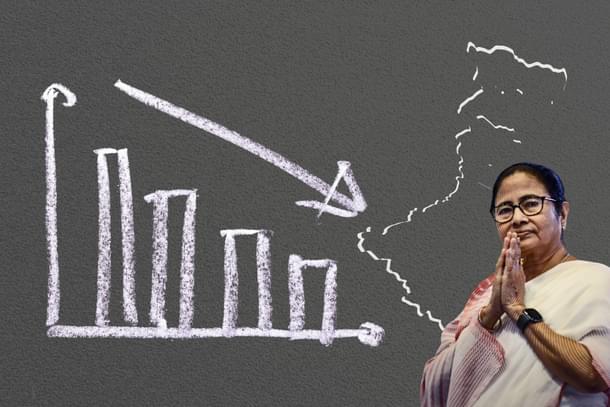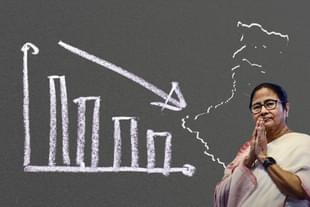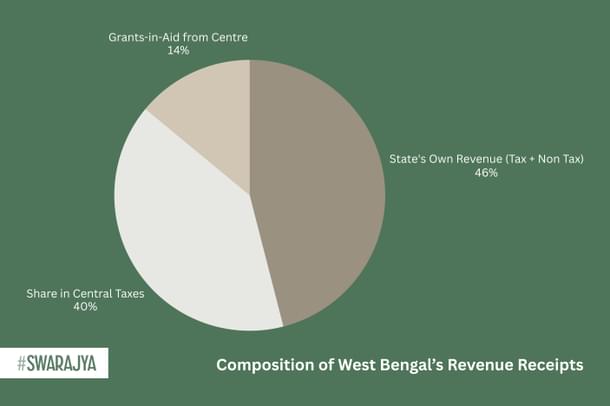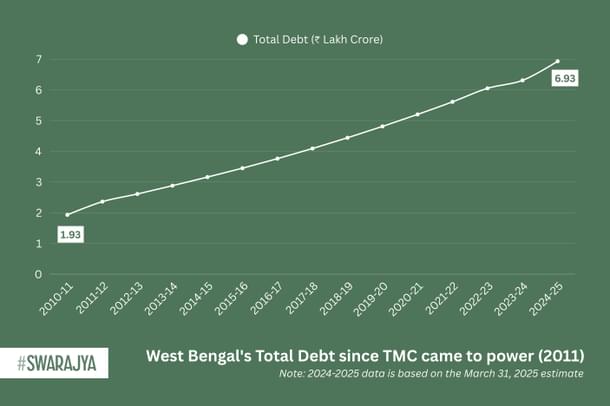West Bengal
Bengal's Empty Coffers Are Becoming Fiscal And Electoral Nightmares For Mamata
Jaideep Mazumdar
Jun 05, 2025, 11:34 AM | Updated 01:40 PM IST
Save & read from anywhere!
Bookmark stories for easy access on any device or the Swarajya app.


Three weeks ago, Chief Minister Mamata Banerjee sat down with state chief secretary Manoj Pant, top officers of the state finance department and two close aides to decide on enhancing the quantum of payouts under some of her important social welfare schemes, including the flagship Lakshmir Bhandar scheme.
With the crucial Assembly elections in the state just about a year away, Mamata Banerjee knows that the easiest way to sail to power for the fourth consecutive term is by enhancing the existing doles and also rolling out new ones, besides undertaking infrastructure projects, especially in rural and semi-urban areas.
At the meeting, it was decided in principle to enrol additional beneficiaries under the Lakshmir Bhandar, Banglar Bari (the state’s answer to PM Awas Yojana) and other welfare schemes and enhance the payouts under some of the projects. The meeting also decided to undertake construction of new roads and upgrade and repair existing ones all over the state.
“An informal working group headed by former finance minister Amit Mitra (he is now the special advisor to the Chief Minister on finance) and comprising the chief secretary, senior officials of the finance department as well as Minister of State for finance Chandrima Bhattacharya, among others, was constituted to chalk out concrete recommendations and work out the financial implications. The group was also tasked with recommending ways to mobilise resources for the welfare schemes,” a senior officer of the state finance department told Swarajya.
SC order on DA arrears
But a bolt from the blue in the form of a Supreme Court interim order asking the state to clear at least 25 percent of dearness allowance (DA) arrears to more than 13 lakh state government employees and pensioners dealt a debilitating blow to Mamata Banerjee’s plans.
The apex court, in an order issued May 16, dismissed the Bengal government’s challenge to a May 2022 Calcutta High Court order asking the state to pay its employees DA at par with central government employees with retrospective effect from January 1, 2006 till December 31, 2015.
The total DA arrears during this ten-year period amounts to a whopping Rs 41,770.95 crore. The Supreme Court asked the state to pay 50 per cent of the arrears within three months before a final hearing of the case in August this year.
However, after the state pleaded that paying nearly Rs 21,000 crore as DA arrears “will break Bengal’s back”, the apex court agreed to scale down the amount to 25 per cent of the total arrears. That means the cash-strapped Bengal government will still have to pay out Rs 10,422.73 crore to its employees and pensioners by mid-August this year.
“It will be extremely difficult to make this payment of 25 per cent of the arrears. What we’re dreading is if the Supreme Court orders a full payout after the final hearing in August. That’ll play havoc with the state’s finances and will put many existing schemes and projects in severe jeopardy,” the finance department officer added.
Bengal pays its employees only 18 per cent DA as against the 55 per cent DA that central government employees get. Bengal government employees have been demanding parity for many years and had approached the Calcutta HC which ruled in their favour in May 2022.
However, the Bengal government challenged the HC order before the Supreme Court which, after prolonged hearings and many adjournments, passed the interim order two weeks ago.
The Mamata Banerjee government is also dreading the prospect of the Supreme Court ordering the state to pay its employees the DA at par with central employees from January 2016 till date. That, admitted another IAS officer attached to the finance department, would be calamitous for Bengal.
“We’ll have a massive problem paying out even 25 per cent of the DA arrears over the next three months. We will have to rework allocations to various schemes and projects,” said the IAS officer.
Junior finance minister, Chandrima Bhattacharya, puts up a brave front. “We will find a way to fulfill our commitments to the people of Bengal. Under the leadership of our leader Mamata Banerjee, we are committed to not only continuing the various welfare schemes we have initiated, but also widening their ambit. Where there is a will, there is a way,” she said.
Axe will fall on some schemes
But this bravado is not shared by finance department mandarins who are now exploring ways to cut budgetary allocations and non-capital expenses. “We can, with a lot of difficulty, manage to pay out the Rs 10,442.73 crore. But anything more than that will mean drastic slashing down of allocation to ongoing welfare schemes and other projects,” the IAS officer said.
Trinamool Congress seniors said that while the flagship Lakshmir Bhandar scheme under which Rs 1,000 (to OBC and other women) to Rs 1,200 (to SC/ST women) is paid per month to about two crore beneficiaries, would be left untouched, payouts under other schemes are likely to be slashed.
According to Bengal’s 2025-2026 budget estimates, Rs 26,000 crore will be spent on this scheme during the current financial year.
The state had allocated Rs 66,300 crore for various welfare schemes and projects in the 2025-2026 budget. Chief Minister Mamata Banerjee was planning to announce enhancement of the monthly dole and also increase in the number of beneficiaries by early next year. But she will have to keep those plans on hold.
Under the Banglar Bari scheme, launched by Mamata Banerjee in December last year after the Union Government refused to disburse funds under the Prime Minister Awas Yojana due to large-scale anomalies in its implementation in Bengal, 12 lakh beneficiaries are being given Rs 1.2 lakh each to construct pucca houses.
While Rs 60,000 has already been disbursed as the first instalment to each of the 12 lakh beneficiaries, the remaining amount of Rs 7,200 crore is due by July end. “The chief minister was keen to bring in another four lakh beneficiaries under this scheme. But that would mean an additional expenditure of Rs 4,800 crore which the state can ill-afford now,” said the finance department officer.
According to Trinamool Congress seniors, while the announcement about adding another four lakh beneficiaries to the Banglar Bari scheme will be made, the disbursement of the first tranche of funds to the new beneficiaries is likely to be delayed. Ditto with the Lakshmi Bhandar scheme.
They told Swarajya that infrastructure projects would also bear the brunt. “The usual post-monsoon repair of roads and state highways, especially rural roads, will be affected by the expected severe funds crunch. And allocations to other infra projects will also be slashed and their disbursements delayed.
“The focus will be on somehow running the flagship schemes like Lakhir Bhandar. The other schemes will suffer,” a senior cabinet minister who wanted to remain anonymous told Swarajya.
According to him, allocation to schemes like Krishak Bondhu (assistance to farmers), student credit cards, ‘Bhyabisyat credit card’ (subsidies and collateral free loans to young entrepreneurs), pensions to widows and people belonging to SC and ST categories, Kanyashree (financial incentives to girl students), Rupashree (financial assistance to girls from poor families to meet wedding expenses), Shikshashree (financial assistance to SC/ST students), Medhashree (pre-matric scholarship to OBC students), Bangla Shasya Bima (crop insurance scheme), Taruner Swapna (financial assistance to students for purchasing laptops, tablets or personal computers), Sabuj Sathi (free bicycles to high school students), Chaa Sundari Prakalpa (free housing for tea garden labourers) and Jal Swapno (tap water connections to two crore households) will be slashed and future payments to crores of beneficiaries of these schemes will be delayed.
But such steps will, fear Trinamool Congress seniors, adversely affect the image of the Mamata Banerjee government. However, there is no way the state can disobey the apex court and delay payment of DA arrears to its employees.
“The opposition is sure to take advantage of any cut or delay in allocations to welfare schemes and projects and carry out a campaign against us. The political fallout of this will be grave. If doles are delayed or reduced instead of being enhanced, we will lose public support,” the minister said.
Why the DA arrears payout will hurt Bengal
Economists point out that for a state whose gross state domestic product (for 2025-2026) is projected to be Rs 20,31,805 crore (a growth of 12 per cent over the last fiscal at current prices), an extra, even though unplanned, expenditure of Rs 10,422 crore should not make the state’s finances go haywire.
Bengal’s total expenditure, excluding debt repayment, has been pegged at Rs 3,41,462 crore. Add to that the estimated debt repayment of Rs 47,732 crore, and the total annual expenditure balloons to Rs 3,89,194 crore.
But the state’s total revenue receipt is estimated to be Rs 2,68,284 crore, thus leaving a huge revenue deficit. Bengal has been bringing down the revenue deficit — it is estimated to be 1.7 per cent of the GSDP this fiscal as compared to 2.4 per cent of the GSDP last financial year — but needs to increase its revenue receipts and cut down on expenditure, especially the doles, to pull itself out of the red.
Of the total revenue receipts, the state’s own tax revenue is pegged at Rs 1,12,544 crore. But, as in all previous years, the actual tax receipts will be lower by about Rs 2,500 crore, say state finance department officials.
Bengal’s share of central taxes is estimated at Rs 1,06,999 crore and the state expects another Rs 37,158 crore as grants-in-aid from the Union Government.

Also, though the fiscal deficit is estimated to be Rs 73,178 crore (3.6 per cent of the state’s GSDP) this financial year, it will surely increase to more than 4 per cent of the GSDP by the end of March 2026.
According to Bengal’s 2025-2026 budget estimates, the state plans to borrow Rs 63,040 crore this financial year to bridge the revenue deficit. But this will add to the state’s already huge total debt burden of Rs 6.93 lakh crore (estimated as on March 31, 2025).
The state’s debt has only been increasing over the last 14 years that Mamata Banerjee has been in power in the state.
In 2011, when she came to power, the state’s total debt was Rs 1.97 lakh crore. Borrowings, necessitated by expenditures and doles aimed at strengthening the Trinamool’s grip on power, has put Bengal deep into the red and emptied the state’s coffers.

Economist Kaushik Banerjee told Swarajya that Bengal’s burgeoning debt burden, its small tax base and very modest revenue receipts, its inability to mobilise resources, financial indiscipline and imprudent spending has forced the state into an “unenviable hand to mouth existence”.
“Any unforeseen expenditure, like the DA arrears payout, thus wreaks havoc with the state’s finances and upsets the tight budget. Financial misgovernance is solely responsible for this sorry state,” Banerjee said.
Dipankar Bag, who used to teach economics at a college affiliated to Calcutta University, says that the current government’s profligacy and lack of big investments which would have hiked Bengal’s revenue, along with dwindling returns from agriculture and the state’s largely subsistence economy is a recipe for financial disaster.
The Niti Aayog ranked Bengal at 16 (out of 18 states) in the fiscal health index and asked the state to prioritise capital expenditure and improve revenue mobilisation through better tax compliance. The Niti Aayog also strongly recommended that Bengal implement stringent measures for fiscal discipline.
But the Supreme Court order on DA arrears payout has made this task very difficult. Chief Minister Mamata Banerjee simply cannot stick to her original plan of announcing new doles, increasing the quantum of existing ones and also expanding the pool of beneficiaries (of doles).
With limited room to increase borrowings or boost revenue, the Bengal government may have to balance key welfare schemes like Lakshmir Bhandar by reducing capital expenditure and postponing or scaling back other programmes, such as student scholarships.
Late last week, the state Directorate of Treasuries and Accounts, asked all departments to seek prior approval for paying any bill worth more than Rs 10 lakh.
Leader of opposition Suvendu Adhikari highlighted the directive to drive home the point that Bengal is in a financial mess and its coffers are empty since the government cannot pay bills worth even Rs 10 lakh.
Mamata Banerjee, thus, finds herself caught between the fiscal devil and the deep sea of bankruptcy. She has to honour the Supreme Court order, and she also has to find the money to continue the doles.
Not doing either will land her in a bigger mess that she finds herself in right now.




